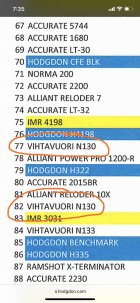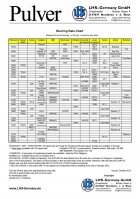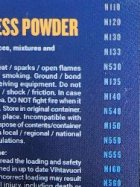There are several such if you research powder manufacturers' websites. If you mean, does some supra-industry body like SAAMI carry out independent research and publish a table with true relatives, then 'No!' For two reasons - it'd still be inaccurate because burn rate is affected by application, and b) the correct and official answer is that you choose from published loads in a particular cartridge carried out by people using industry standard spec barrels and chambers and pressure measuring gear. Nobody is going to even hint that you should go investigating your own pic&mix choices ........... and if you do, you're on your own if it ends up badly.
There is also the Unique Norma table that uses a common 308 Win load and indexes grades against a benchmark 100 value for IMR-4350 on two metrics - relative pressure and MV.
https://www.norma-ammunition.com/en-gb/reloading-data
...... and scroll down to the table. (Unfortunately, it's an old piece and lacks several modern powders including H. VarGet, but is still very useful in comparing it against conventional charts - Many Viht grades come out as much faster relative to others than Viht's own and most other tables show.)
There is no such thing as an accurate burn rate chart, especially since the effective rate often changes according to application. ie Powder 'A' might be slower than 'B' in 308 Win, but that's reversed in 45-70 or a large case magnum. All published charts are based on manufacturers' own results from 'closed bomb' tests and there appears to be a lack of consistency between their approaches.
If you don't have doubts about their value, look at the short piece here:
https://www.chuckhawks.com/powder_burn_rate.htm
So, you can ask that if true, why do we have/use them at all? The answer is because flawed as they are, there isn't a better alternative. The important thing is to look at them as a general guide to possible alternative powders / applications of an unknown grade. Lacking such a reference, you return to saying, Powder 'A' is useful in 222 Rem; 223 Rem (but with lighter bullets only); ................... etc etc and half of reloading manuals' pages would be such descriptions given the number of powders and cartridges now in use.
What you can't do - yet we see it all the time on forums - is to draw lines between apparently same rate grades on burn rate charts and extrapolate that to charge weights. Worse still, is to firstly do such an extrapolation job then interpolate believed rates and charges - ie Powder 'C' lies on the chart between powders 'A' and 'B', so I'll take their maxima in say 30-06 for this pair and split it for 'C'.
My preferred chart - if I must use one - is from the German shooting distributor LHS.
Here's one from some years back pre EU REACH introduction. There are later versions with recent newer powders included if you Google the topic and company, but unfortunately they omit all the Hodgdon/IMR/Winchester REACH non-compliant products that are no longer imported into Europe, so you can't do comparisons between them and say Viht grades. To take an example from it, Lovex S065 (Shooters World 'Long Rifle' in the US) is shown in this chart as being '4 lines slower burning' than H. VarGet and 'one line slower' than Re15 ending up roughly midway between the 4895s and 4350s. SW's chart is in line with this, as are published loads and actual shooting results on the range. When the manufacturer Explosia introduced the powder into the UK c. 12 years ago, its own burn rate chart showed (and still does) that it was 'equal to' VarGet, ie printed on the same horizontal line. As there was not a single tin of VarGet or H4895 available in the country at the time, it was promoted as a 'VarGet substitute' - it wasn't and still isn't - too slow burning in practice, too bulky, and not enough energy to even approach the Hodgdon powders' performance in applications like 308 Win even running with heavily compressed loads. Sales collapsed and it's never fully recovered here - 'Useless rubbish!' is one of the kinder epithets I heard from a large retailer. Yet, it's an excellent powder in correct applications - 260 and 7mm-08 Rem, 7X57 Mauser and 7X64 Brennecke, great for 6.5 Creedmoor says SW which I can't confirm but would well believe. Compare half a dozen charts and you find examples of changed place orders between them, sometimes like this example of considerable significance.
Another example - the now withdrawn IMR-4166 is listed in Hodgdon's data between H4895 and VarGet, so on the face of it is ideal for 223 Rem with 77s and 80s. Try and find a pressure barrel tested load in any manuals, or online, other than Hodgdon's own Annual Manual though! And in Hodgdon's data, 4166 has a considerably lower 223/77 maximum for an MV over 100 fps lower than with H4895. Lyman 51 now finally lists it for 223 in as far as I can see the sole non-Hodgdon source, and the same low maximum charge and MV applies, and I can confirm that result through range-testing. It acts in this application as if a much faster burner than the two ADI manufactured Hodgdon powders and pressures out at considerably lower charges.
View attachment 1384906



















